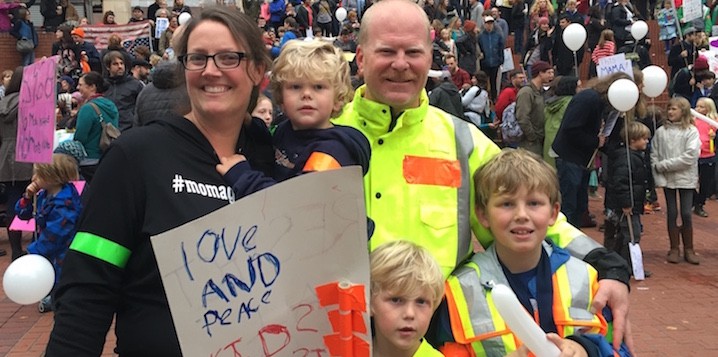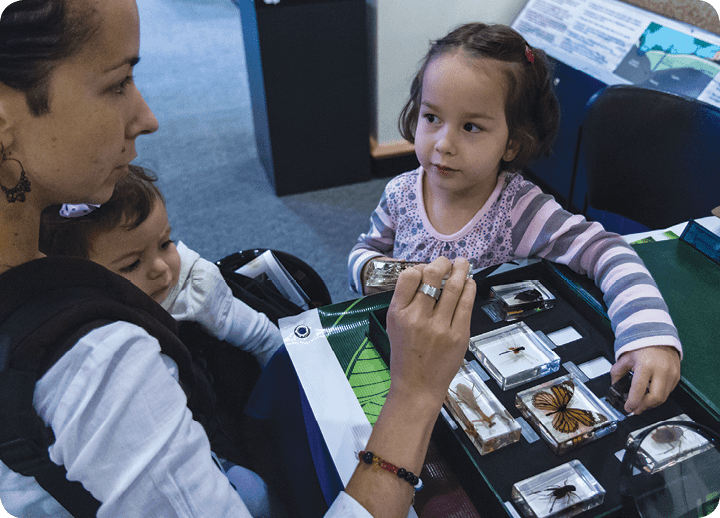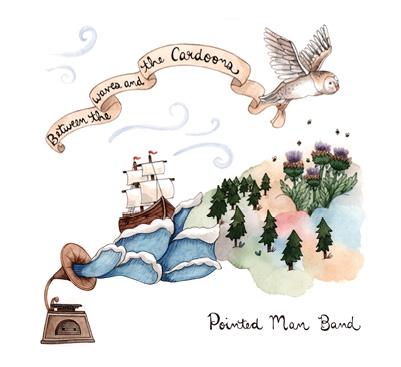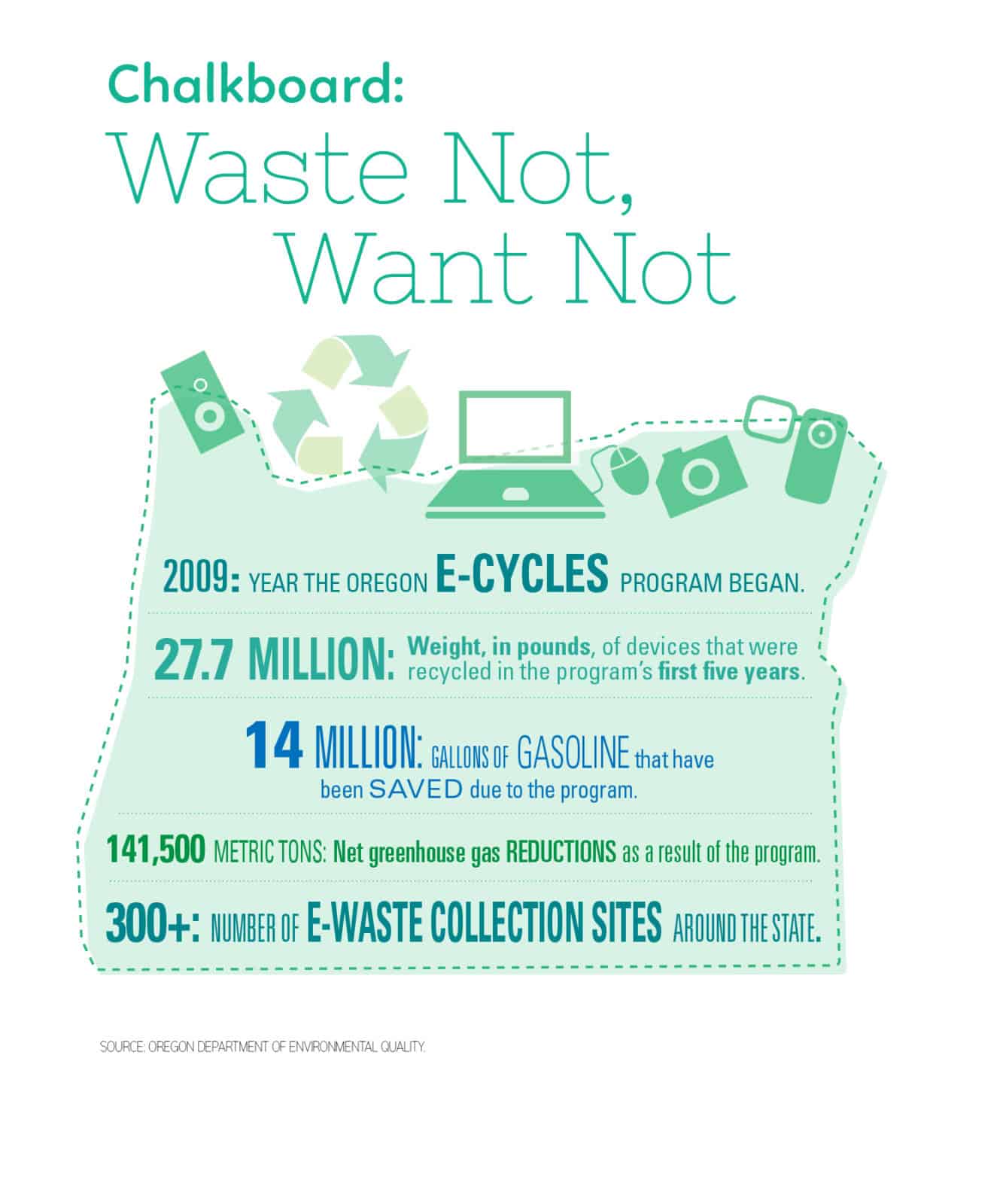
Take Five: Shannon Berger-Hammond
After the recent election, Shannon Berger-Hammond and her friend Erika Wixon were struggling with how to explain to their children that Donald Trump was going to be the 45th president of the United States. In November, they formed Families for Peaceful Protest (FFPP) as a way for all families to speak up for their rights —and for the rights of marginalized communities. Berger-Hammond, a Foster Powell resident who is the mother of three boys ages 3, 6 and 8, talked with us about why it’s important for kids to learn their civics lessons close up and what’s next for FFPP. For more information about their upcoming Earth Day rally, visit facebook.com/familiesforpeacefulprotest.
Q: Your group helped organize the pre-rally for families at the Portland Women’s March in January. Do you have an estimate of the number of families who showed up?
A: A few thousand families attended, if not more. We continuously heard from families that they would not have brought their children to the march had there not been a space for them to do so.
Q: How do you respond to people who say children shouldn’t attend protests?
A: I think the question should be “Why wouldn’t children attend protests?” This is their community, their families, their schools, their health care, their environment, their rights. They are the people that these long-lasting changes will affect the most. Protesting is how lasting social change has been made in the U.S. We are instilling that when we see that something is not right, we stand up and make our best effort to change it.
Q: What are some of the best kids’ signs you’ve seen at a protest?
A: Some of my favorites have been: “I’m little, I’m loud”, “Make America Girl Again”, “Kids have a voice too” and “Kids matter.” But the best signs were colorful scribbles with hearts, stars and streamers.
Q: Do you know any kids’ books about social justice that you’d recommend?
A: Yes! Stella by Starlight by Sharon M. Draper • One Crazy Summer by Rita Williams-Garcia • Sylvia & Aki by Winifred Conkling • Operation Redwood by S. Terrell French • Return to Sender by Julia Alvarez • Mama’s Nightingale: A Story of Immigration and Separation by Edwidge Danticat • Stepping Stones: A Refugee Family’s Journey by Margriet Ruurs • Oskar and the Eight Blessings by Richard Simon and Tanya Simon.
Q: What is Families for Peaceful Protest working on next?
A: We are working on building a website and turning into a nonprofit organization, so we have the ability to endorse candidates, raise funds for families in need, and work as an advocacy group for marginalized families and children in the Portland area. We are hoping to create chapters in other cities as well. — Denise Castañon

TOP 5 …Nature Centers
➊ Check out the preschool and toddler-friendly exhibits at the Cooper Mountain Nature House in Beaverton. Guided hikes leave from here, too.
➋ Meet some of our region’s avian inhabitants at the Audubon Society of Portland’s nature education center, then explore their Forest Park habitat on the miles of trail out the front door.
➌ The ecology of wetlands steps into the spotlight at the Jackson Bottom Wetlands Preserve’s education center in Hillsboro. Don’t miss their bald eagle’s nest exhibit, either.
➍ The Tualatin Hills Nature Center in Beaverton offers environmental education programming year-round.
➎ We’re big fans of the fantastic interactive exhibits at the Water Resources Education Center in Vancouver.
— Julia Silverman
Gear Guide: These Boots are Made for Hiking
With winter’s chill finally lifting, it’s the perfect time to hit the trails with your family. These kicks are sure to keep your kids scrambling about as sure-footedly as mountain goats.
Portland-based KEEN offers the Oakridge waterproof boot, which marries durability with a breathable lightweight design. Also a plus — odor-fighting technology. Bungee laces for little kids, Velcro for bigger kids. Also available in brown and blue/green. $70. Keen.com.
Merrell’s Capra hiking boot is fully waterproof but also allows unwanted moisture to escape. And the rugged sole really helps your kiddos get good traction on the trail. Also available in brown and blue/pink. $65. Merrell.com.

Playlist: PNW Point of View
If you took the essence of PDX, that cool, cloudy and somewhat quirky aura that makes Portland Portland and alchemized it into an album of music, then you’d get Pointed Man Band’s Between the Waves and Cardoons. Pointed Man Band, aka Portland dad Dan Elliott, says his music is for the “grown and still growing.” So while it’s billed as “kids’ music” it’s something I’d listen to even with when my kids are not around. The album’s complexity and upbeats don’t make it as easy to sing along to as, say, Bananaphone — but as much as I love him, parents can’t live on Raffi alone. Still your kids will dig the crashing cymbals in The Waves. And older kids will appreciate the salmon and bee point of view in the songs in Upstream and Pollination. Available on iTunes and Amazon.com. Pro tip: Catch Pointed Man Band in person at his weekly show on Mondays at Know Thy Food Cooperative at 10:30 am. — D.C.
Bookshelf: A Swiftly Tilting Planet
Get ready for Earth Day with these nature-inspired read-alouds (and calls-to-action) from Kim Tano and Richard Corbett, the children’s book buyers at Powell’s Books, Portland’s beloved independent bookstore.
The Earth Book by Todd Parr
Even a kid can do their part to save the planet, following Parr’s simple, but never simplistic, plan. Better yet, they will understand why it is so important, thanks to his clear, direct prose: “I use both sides of the paper and bring my own bags to the market/Because I love the trees and want the owls to have a place to live.” $11.99.
The Tiny Seed by Eric Carle
Just right for welcoming spring, this board book tells the story of a seed’s journey through a myriad of dangers — blown by the wind, nearly eaten by a bird — to become a flower. Carle’s trademark colorful collages bring the story to life. $8.99.
The Curious Garden by Peter Brown
Loosely based on the rebirth of the High Line in New York City, this lushly illustrated picture book follows a boy who turns his brown, smoggy city into a green wonderland, starting with some forgotten plants that refuse to die on an abandoned rail line. $18.
Make the Earth Your Companion by J. Patrick Lewis
This tread-lightly poem touches on so many of the habitats that make Oregon so special — the sea, the rivers, the mountains, the wetlands, the desert, the woods. A nice reminder that the Earth is everyone’s home. $18.99.
Who Was Rachel Carson by Sarah Fabiny
We love the Who Was series of children’s biographies, especially this one, on environmental pioneer Rachel Carson. Learn all about her grassroots movement on conservation and preservation, including her groundbreaking research on the dangers of DDT and other pesticides. $5.99.
Nature’s Day by Kay Maguire
Nature’s Day explores nine different locations throughout the world, spanning all four seasons. It’s gloriously illustrated and packed with information about flora and fauna alike. Also check out the companion activity book, Nature’s Day Out and About, for nature crafts and treasure hunts. $9.99.
For our money, the best way to celebrate Earth Day is by doing some good for our lovely green planet. This year, you can indulge your inner naturalist to boot. Sign up with the kids for the Sandy River Delta “Eco-Blitz.” Your family will work alongside trained biologists to map and document the hundreds of species that live at the delta. The information is used to inform conservation and habitat protection programs in years to come. It’s open to all ages, but please RSVP to bill@sandyriver.org so they know how many people to expect. Saturday, April 22, 9 am-3 pm at the Sandy River Delta Park in Troutdale. — J.S.
Getaway: Shakespeare in Love
Maybe you think that bucolic Ashland, in southern Oregon, is a grown-ups only destination, given that not so many little kids might want to sit through Julius Caesar and Henry IV, Parts 1 and 2, no matter how stunning the setting? Think again. The home to the Oregon Shakespeare Festival is chock-full of kid-friendly fun, including its legendary stages.
This year, the festival is staging its own version of Disney’s Beauty and the Beast, at the iconic, outdoors Allen Elizabethan Theater, from mid-June to October. (Kids must be 6 or older to attend.) Sign up for a free family day prologue to go behind-the-scenes with an OSF educator, who will set the stage, so to speak, for the evening’s entertainment. And right before the show, head to “the bricks” at the center of OSF’s complex, for free entertainment from a variety of performers. Need a break from the theatergoing? Try nearby Lithia Park, the city’s pride and joy, which has an awesome play structure, a duck pond, and trails that wind up into the nearby hills. (Locals tell us the sandbox at North Mountain Park in east Ashland is another winner.) Or if the weather isn’t cooperating, head to the ScienceWorks museum on Main Street, which is like a mini-OMSI. We dig the Da Vinci’s Garage for some hands-on tinkering. When the kids get hungry, fill ’em up with southeast Asian-influenced BBQ at Tot Restaurant, tucked into a shopping district off the main drag. Stay at the Stratford Inn Best Western, which has an outdoor pool and rooms influenced by none other than the Bard himself. *Note, Ashland is a long 5-hour drive — but a super-quick flight to Medford. Time to use some miles! — J.S.

We Recommend
You know the drill. Every year or so, the drumbeat starts — there’s a new laptop about to hit the market. It’s sleeker and slimmer, can store your entire life and then some, holds a battery charge for a week at a time and comes with a nontoxic, super-safe kid-repellent that activates every time your preschooler tries to log onto Netflix. Okay, maybe that last part isn’t exactly true. And maybe you’re able to resist that siren song. But chances are, your household’s got at least some electronic waste hanging around, collecting dust on a shelf. This Earth Day, take advantage of Oregon’s excellent e-waste program and clean them out. The program is paid for by electronics manufacturers, and allows you to recycle up to seven items for free at designated e-cycling stations around the state. That includes computers, monitors, mice, televisions, printers and keyboards. (Just be sure, if you’re bringing in a computer, that you’ve wiped the hard drive clean to protect your personal data.) Electronics recycling means keeping all kinds of bad stuff out of the air we breathe, like lead, cadmium and mercury, all toxic materials that are in our old computers and other gear. Plus, the program’s reductions to greenhouse gas emissions is the equivalent of knocking out the tailpipe emissions from about 30,500 average passenger cars, per year. Still have more stuff? Meet Free Geek, in inner SE Portland, which takes in electronics from all decades and turns it into useful stuff, including rewired computers that are given free-of-charge to nonprofits and community-change organizations. Check out more about e-cycling at oregon.gov/deq and tune in to Free Geek at freegeek.org. — J.S.
Ask Dr. Corey: The Facts on Fluoride
Q: Does my toddler really need fluoride drops? I’ve heard fluoride is linked to cognitive impairments.
A: The best estimates we have suggest that almost half of children age 2-11 in the United States have cavities in their primary (“baby”) teeth. Cavities, even in primary teeth, can cause problems with infections and gum disease.
(Communities with fluoride in their drinking water have between 20-40 percent less dental disease than communities without, even with easy access to things like fluoride supplements or toothpaste.)
Despite the overwhelming evidence that fluoride is effective in reducing dental disease, there continues to be concern over its use. Research groups worldwide have taken these concerns seriously and there is a large amount of evidence to show that fluoride either added to the water supply or ingested separately is completely safe.
With regards to brain function, there is no data that fluoride, in recommended dosages, impacts brain function in a negative way. Researchers have looked at brain function in areas with 10 times the amount of natural fluoride in the water as we have here in Oregon and the subsequent possible effects on brain development. Some question whether infants exposed to these high levels while in the womb may be at risk of delays later on, but certainly nothing’s concrete at this point.
The good news is that for most low-risk children, i.e. those without weak enamel or a strong family history of dental disease, a fluoride-containing toothpaste from the time of the appearance of the first teeth is probably adequate for a supplement.
I follow the American Academy of Pediatrics and the American Dental Association recommendation of a grain
of rice-sized amount of fluoride containing toothpaste while brushing for children under 3 years old. It is perfectly okayif they swallow it, in fact, that’s precisely the idea! Children between 3 and 6 may use a pea-sized amount. Once children learn to spit, usually around age 5 or 6, we don’t worry so much about using too much toothpaste.
- August 2024 Digital Issue - July 26, 2024
- 25 Free Things to Do With the Family in August - July 26, 2024
- Our Favorite Free and Splurgy Summer Date Night Ideas - July 20, 2024







